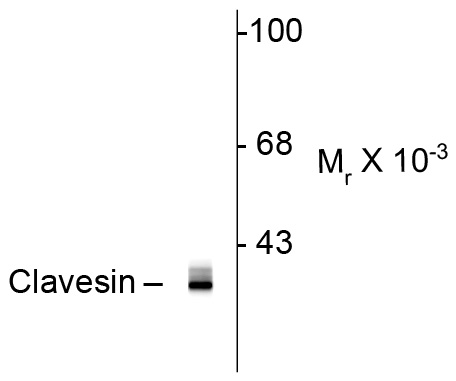Clavesin 1/2 Antibody
Affinity purified rabbit polyclonal antibody
- SPECIFICATION
- CITATIONS
- PROTOCOLS
- BACKGROUND

Application
| WB |
|---|---|
| Primary Accession | A6JFQ6 |
| Reactivity | Rat |
| Predicted | Human, Mouse |
| Host | Rabbit |
| Clonality | polyclonal |
| Calculated MW | 35 KDa |
| Gene ID | 366311 |
|---|---|
| Gene Name | CLVS1/2 |
| Other Names | Clavesin-1, Retinaldehyde-binding protein 1-like 1, Clvs1 {ECO:0000303|PubMed:19651769} |
| Target/Specificity | Synthetic peptide corresponding to amino acid residues from the C-terminal region conjugated to KLH. |
| Dilution | WB~~ 1:1000 |
| Format | Prepared from serum by affinity purification using a column to which the peptide antigen was coupled. |
| Antibody Specificity | Specific for the ~ 35 kDa clavesin 1/2 protein doublet in Western blots ofrat brain lysate. Isoform-specific knock down in cultured hippocampal neurons indicates that thelower and upper bands are clavesin 1 and 2, respectively. |
| Storage | Maintain refrigerated at 2-8°C for up to 6 months. For long term storage store at -20°C in small aliquots to prevent freeze-thaw cycles. |
| Precautions | Clavesin 1/2 Antibody is for research use only and not for use in diagnostic or therapeutic procedures. |
| Shipping | Blue Ice |

Thousands of laboratories across the world have published research that depended on the performance of antibodies from Abcepta to advance their research. Check out links to articles that cite our products in major peer-reviewed journals, organized by research category.
info@abcepta.com, and receive a free "I Love Antibodies" mug.
Provided below are standard protocols that you may find useful for product applications.
Background
Clavesin (clathrin vesicle associated Sec14 protein) is a novel neuron specific protein that has recently been identified and shown to be required for normal morphology of late endosomes and/or lysosomes as lentiviral-mediated knockdown of clavesin in hippocampal neurons causes lysosomal defects (Katoh et al., 2009). Additionally, upregulation of clavesin in human hepatocellular carcinoma has recently been demonstrated thus making it a useful marker for this disease state (Zhao et al., 2008).
References
Yohei Katoh, Brigitte Ritter, Thomas Gaffry, Francois Blondeau, Stefan Höning and
Peter S. McPherson (2009) the clavesin family: neuron-specific lipid- and clathrin-binding Sec14
proteins regulating lysosomal morphology. Journal of Biological Chemistry Oct
2;284(40):27646-54.
Zhao S, Xu C, Qian H, Lv L, Ji C, Chen C, Zhao X, Zheng D, Gu S, Xie Y, Mao Y (2008)
Cellular retinaldehyde-binding protein-like (CRALBPL), a novel human Sec14p-like gene
that is upregulated in human hepatocellular carcinomas, may be used as a marker for human
hepatocellular carcinomas. DNA Cell Biol. Mar; 27(3):159-63.
If you have used an Abcepta product and would like to share how it has performed, please click on the "Submit Review" button and provide the requested information. Our staff will examine and post your review and contact you if needed.
If you have any additional inquiries please email technical services at tech@abcepta.com.













 Foundational characteristics of cancer include proliferation, angiogenesis, migration, evasion of apoptosis, and cellular immortality. Find key markers for these cellular processes and antibodies to detect them.
Foundational characteristics of cancer include proliferation, angiogenesis, migration, evasion of apoptosis, and cellular immortality. Find key markers for these cellular processes and antibodies to detect them. The SUMOplot™ Analysis Program predicts and scores sumoylation sites in your protein. SUMOylation is a post-translational modification involved in various cellular processes, such as nuclear-cytosolic transport, transcriptional regulation, apoptosis, protein stability, response to stress, and progression through the cell cycle.
The SUMOplot™ Analysis Program predicts and scores sumoylation sites in your protein. SUMOylation is a post-translational modification involved in various cellular processes, such as nuclear-cytosolic transport, transcriptional regulation, apoptosis, protein stability, response to stress, and progression through the cell cycle. The Autophagy Receptor Motif Plotter predicts and scores autophagy receptor binding sites in your protein. Identifying proteins connected to this pathway is critical to understanding the role of autophagy in physiological as well as pathological processes such as development, differentiation, neurodegenerative diseases, stress, infection, and cancer.
The Autophagy Receptor Motif Plotter predicts and scores autophagy receptor binding sites in your protein. Identifying proteins connected to this pathway is critical to understanding the role of autophagy in physiological as well as pathological processes such as development, differentiation, neurodegenerative diseases, stress, infection, and cancer.


